
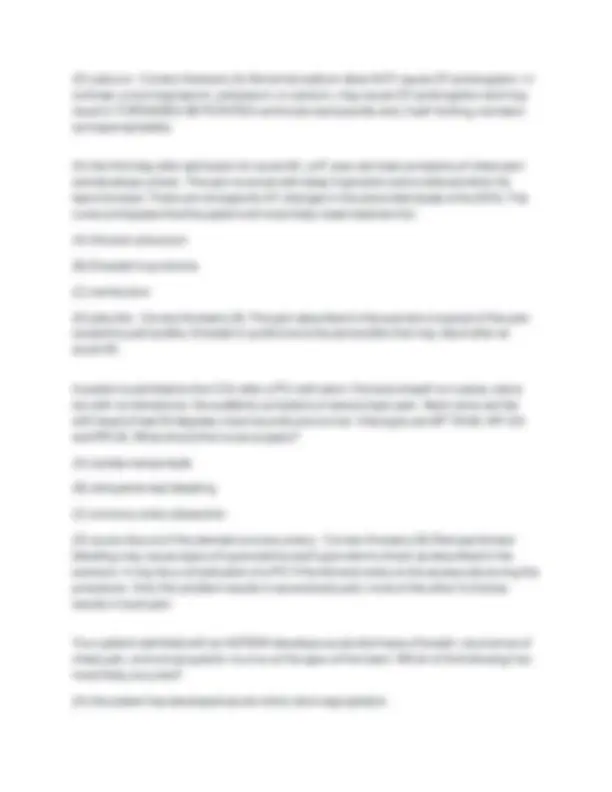
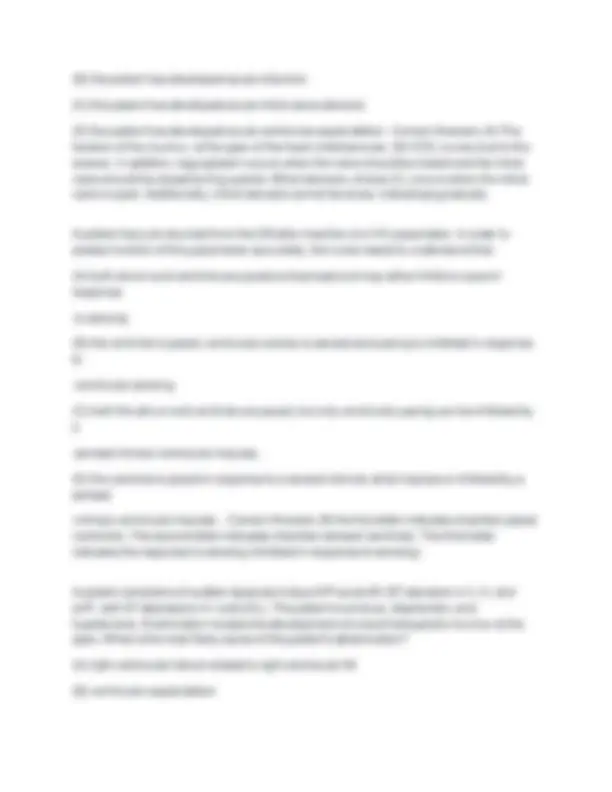
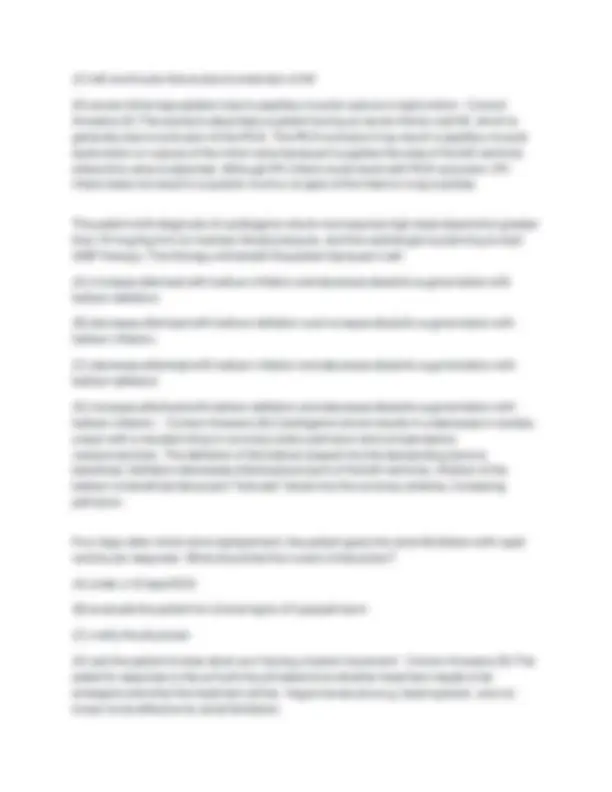
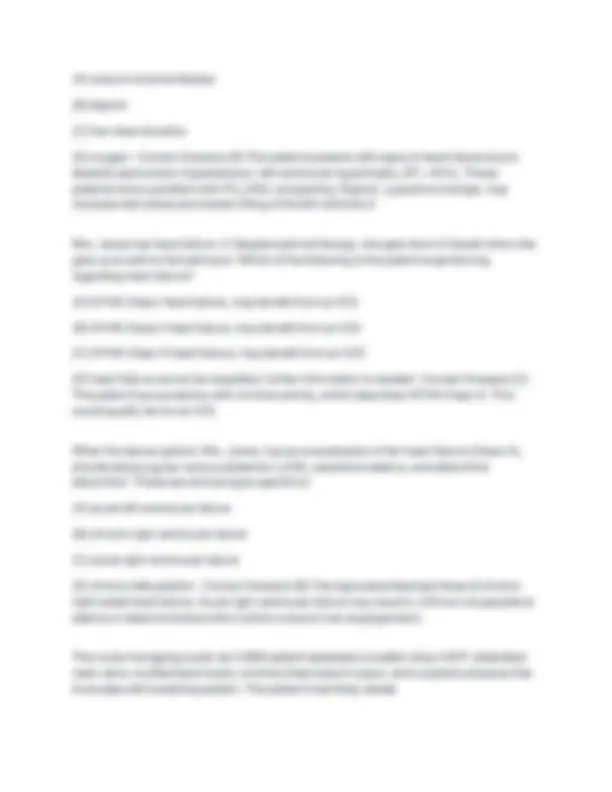
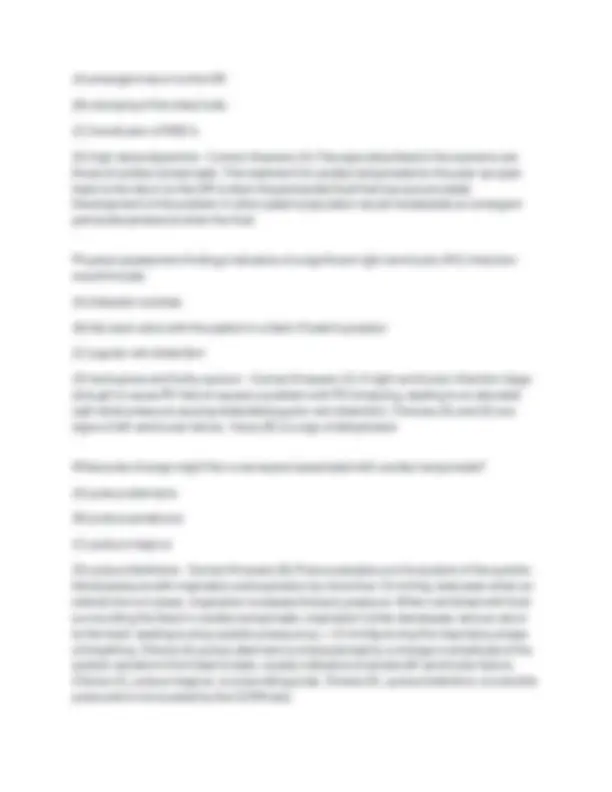
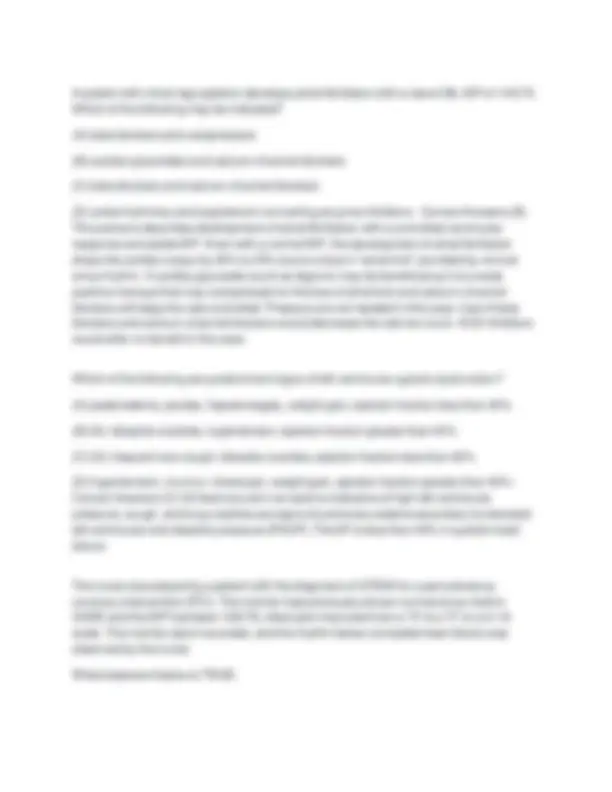
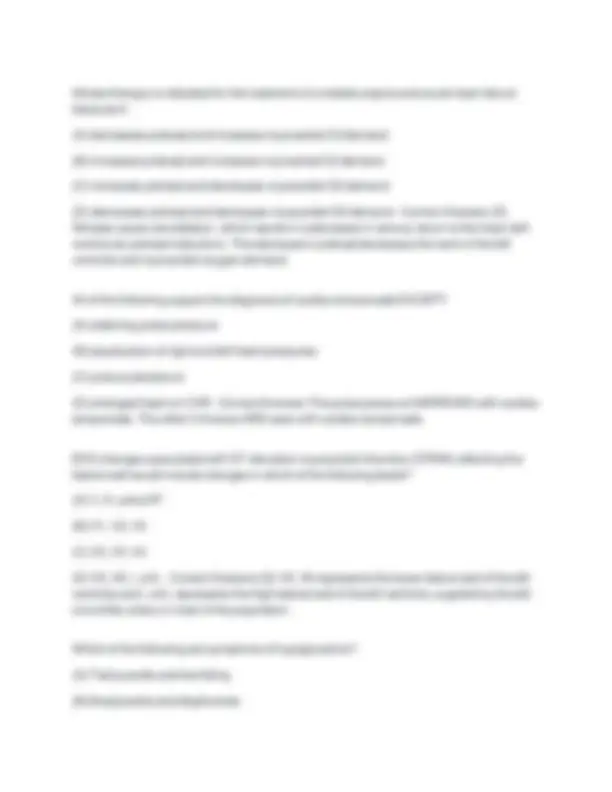
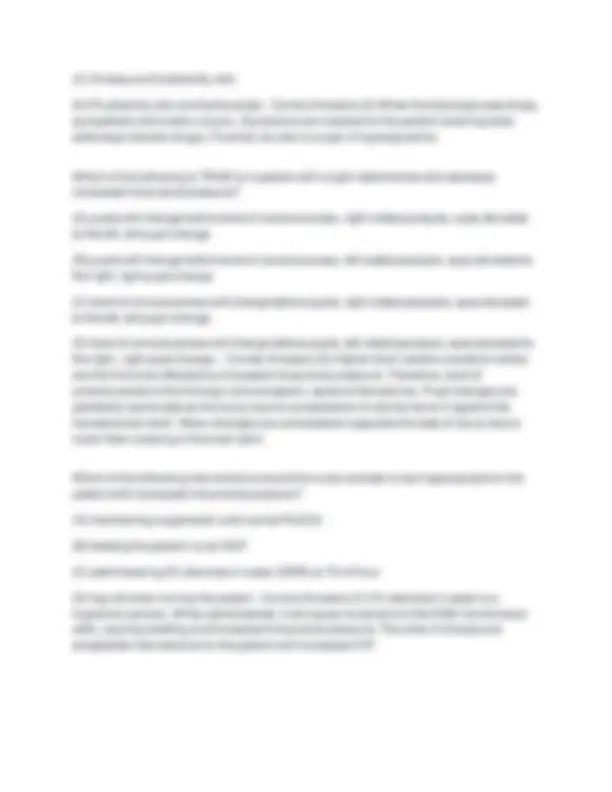
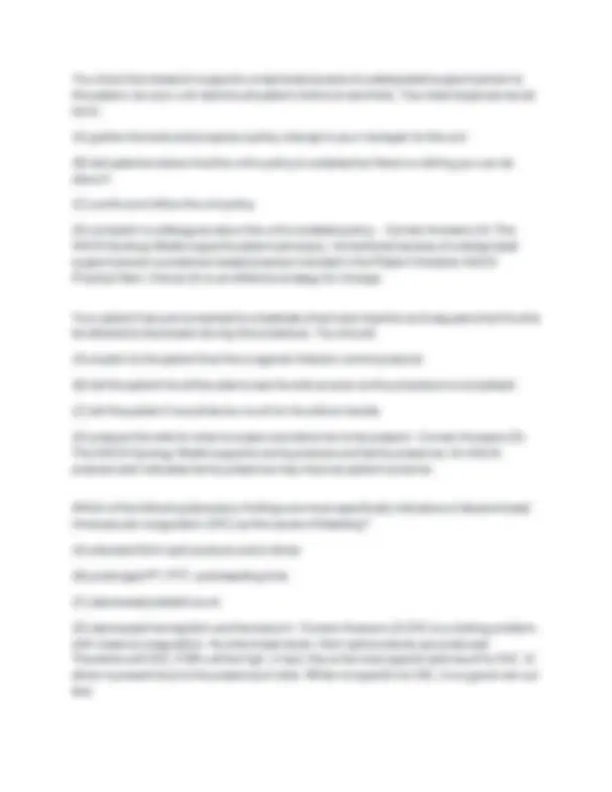


Study with the several resources on Docsity

Earn points by helping other students or get them with a premium plan


Prepare for your exams
Study with the several resources on Docsity

Earn points to download
Earn points by helping other students or get them with a premium plan
Community
Ask the community for help and clear up your study doubts
Discover the best universities in your country according to Docsity users
Free resources
Download our free guides on studying techniques, anxiety management strategies, and thesis advice from Docsity tutors
A comprehensive set of multiple-choice questions and answers related to the ccrn exam 2, focusing on cardiology topics. It covers various aspects of cardiac care, including reperfusion therapy, medication management, heart block, dilated cardiomyopathy, qt prolongation, pericarditis, cardiogenic shock, and pacemaker function. Designed to help students and professionals prepare for the ccrn exam 2 by providing insights into common exam topics and their associated concepts.
Typology: Exams
1 / 16

This page cannot be seen from the preview
Don't miss anything!










A 59 year old male is admitted complaining of chest pain and dyspnea. ST elevation and T wave inversion were seen on the EKG in V2,V3 and V4. IV thrombolytic therapy was started in ED. Indications of successful reperfusion would include all of the following except: (A) pain cessation (B) decrease in CK or troponin (C) reversal of ST segment elevation with return to baseline (D) short runs of ventricular tachycardia - Correct Answers (B)Coronary artery reperfusion due to PCI or fibrinolysis results in an ELEVATION of creatinine kinase (CK) or troponin, not decrease. The theory is that the return of blood flow distal to the occlusion can result in 'reperfusion injury' of the muscle, elevating cardiac biomarkers. The other 3 choices are indicators of reperfusion: Pain cessation, reversal of ST segment elevation with return to baseline, short runs of ventricular tachycardia. Which of the following medication orders should the nurse question for the patient in question 1 - reperfusion question-patient having an MI? (A) metoprolol (Lopressor) (B) aspirin (C) propranolol (Inderal) (D) heparin - Correct Answers (C) The patient in the scenario is having an acute anterior wall MI. A beta blocker is beneficial for an acute MI as these agents decrease the work of the heart and increase the threshold for ventricular fibrillation. Propranolol, although a beta-andrenergic blocker like metoprolol, is NOT a cardioselective beta blocker. It affects beta receptors in heart muscle AND lung tissue. Therefore, it is more likely to cause bronchoconstriction than a cardioselective beta blocker.
The other 3 - cardioselective beta blocker, antiplatelet, and anticoagulation-are indicated in an acute MI. If heart block develops while caring for the patient in question 1 (pt with an MI who went through reperfusion from PCI or fibrinolytic therapy), which of the following would it most likely be? (A) sinoatrial block (B) second degree, Type I (C) second degree, Type II (D) third degree, complete - Correct Answers (C) The patient is having an acute anterior MI, which is generally due to LAD occlusion. The LAD supplies the HIS bundle, which could result in a second-degree, type II heart block. The other 3 types are due to SA node or AV node ischemia, which generally occur with an RCA occlusion — interior wall MI. Appropriate drug therapy for dilated cardiomyopathy is aimed toward: (A) decreasing contractility and decreasing preload and afterload (B) decreasing contractility and increasing preload and afterload (C) increasing contractility and increasing both preload and afterload (D) increasing contractility and decreasing both preload and afterload - Correct Answers (D) Dilated cardiomyopathy is likely to result in systolic dysfunction, which decreases contractility, causes compensatory arterial constriction , and results in a higher left ventricular preload. To treat this, therapy is aimed at increasing contractility, decreasing afterload (arterial constriction), and decreasing preload that is too high.🐀 An 18 year old is admitted with a history of syncopal episode at the mall and has a history of an eating disorder. The nurse notes a prolonged QT on the 12 - lead EKG and anticipates a reduction in an electrolyte to be the cause. Which of the following is LEAST likely to cause this patient's problems? (A) sodium (B) magnesium (C) potassium
(B) the patient has developed acute infarction (C) the patient has developed acute mitral wave stenosis (D) the patient has developed acute ventricular septal defect - Correct Answers (A) The location of the murmur, at the apex of the heart (midclavicular, 5th ICS), is one clue to this answer. In addition, regurgitation occurs when the valve should be closed and the mitral valve should be closed during systole. Mitral stenosis, choice (C), occurs when the mitral valve is open. Additionally, mitral stenosis cannot be acute, it develops gradually. A patient has just returned from the OR after insertion of a VVI pacemaker. In order to assess function of this pacemaker accurately, the nurse needs to understand that: (A) both atrium and ventricle are paced and sensed and may either inhibit or pace in response to sensing (B) the ventricle is paced, ventricular activity is sensed and pacing is inhibited in response to ventricular sensing. (C) both the atrium and ventricle are paced, but only ventricular pacing can be inhibited by a sensed intrinsic ventricular impulse. (D) the ventricle is paced in response to a sensed intrinsic atrial impulse or inhibited by a sensed intrinsic ventricular impulse. - Correct Answers (B) the first letter indicates chamber paced (ventricle). The second letter indicates chamber sensed (ventricle). The third letter indicates the response to sensing (inhibited in response to sensing). A patient complains of sudden dyspnea 5 days S/P acute MI (ST elevation in II, III, and aVF, with ST depression in I and aVL). The patient is anxious, diaphoretic, and hypotensive. Examination reveals the development of a loud holosystolic murmur at the apex. What is the most likely cause of this patient's deterioration? (A) right ventricular failure related to right ventricular MI (B) ventricular septal defect
(C) left ventricular failure due to extension of MI (D) acute mitral regurgitation due to papillary muscle rupture or dysfunction - Correct Answers (D) The scenario describes a patient having an acute inferior wall MI, which is generally due to occlusion of the RCA. The RCA occlusion may result in papillary muscle dysfunction or rupture of the mitral valve because it supplies the area of the left ventricle where this valve is attached. Although RV infarct could result with RCA occlusion, RV infarct does not result in a systolic murmur at apex of the heart or lung crackles. The patient with diagnosis of cardiogenic shock now requires high dose dopamine (greater than 10 mcg/kg/min) to maintain blood pressure, and the cardiologist is planning to start IABP therapy. This therapy will benefit the patient because it will: (A) increase afterload with balloon inflation and decrease diastolic augmentation with balloon deflation. (B) decrease afterload with balloon deflation and increase diastolic augmentation with balloon inflation. (C) decrease afterload with balloon inflation and decrease diastolic augmentation with balloon deflation (D) increase afterload with balloon deflation and decrease diastolic augmentation with balloon inflation. - Correct Answers (B) Cardiogenic shock results in a decrease in cardiac output with a resultant drop in coronary artery perfusion and compensatory vasoconstriction. The deflation of the balloon placed into the descending aorta is beneficial. Deflation decreases afterload and work of the left ventricle. Inflation of the balloon is beneficial because it "boluses" blood into the coronary arteries, increasing perfusion. Four days after mitral valve replacement, the patient goes into atrial fibrillation with rapid ventricular response. What should be the nurse's initial action? (A) order a 12 lead EKG (B) evaluate the patient for clinical signs of hypoperfusion (C) notify the physician (D) ask the patient to bear down as if having a bowel movement - Correct Answers (B) The patient's response to the arrhythmia will determine whether treatment needs to be emergent and what the treatment will be. Vagal maneuvers e.g. bearing down, are not known to be effective for atrial fibrillation.
A postoperative patient on the surgical unit suddenly develops chest pain, extreme weakness, and dyspnea and is found to have ST elevation in II, III, and aVF on the stat EKG. B/P is 92/62, heart rate 58, respiratory rate 28, lungs are clear, and heart sound assessment reveals an S4, no murmurs. In addition to preparing the patient for PCI, which of the following interventions would you anticipate? (A) nitroglycerin drip, aspirin (B) furosemide, atropine (C) transcutaneous pacing, morphine (D) aggressive fluid administration, right-sided EKG. - Correct Answers (D) The scenario describes a patient having an acute inferior STEMI, generally due to RCA occlusion. An RCA occlusion may result in RV infarct, which this patient has signs of (hypotension with clear lungs). The definitive treatment is emergent PCI. Fluid administration will help increase coronary artery perfusion by correcting hypotension and ensure adequate RV preload. The right-sided EKG may help confirm the RV infarct. Nitroglycerin, diuretics, and morphine may decrease preload, which would worsen hypotension. A 52 year old male presents with complaints of blurred vision and shortness of breath. B/P is 232/136, heart rate 102, respiratory rate 28 with crackles in lower lung fields bilaterally, with S3 and S4 heart sounds on auscultation. Which of the following would be indicated for this patient? (A) nitroprusside drip, admit to critical care unit (B) digoxin, furosemide (C) labetalol drip, admit to a medical unit (D) lisinopril, calcium channel blocker - Correct Answers (A) The patient has signs of organ dysfunction (heart failure) secondary to extreme hypertension. Therefore, he has hypertension crisis or emergency. The B/P needs to be emergently decreased. Most often this treatment is best done in an ICU. An 80 year old female presents with chief complaint of acute shortness of breath. Clinical exam reveals B/P 182/102, heart rate 105/minute, respiratory rate 32/minute, lungs with crackles bilaterally, pulse oximetry of 88%, S4 on auscultation. EKG revealed sinus tachycardia, left ventricular hypertrophy pattern, chest radiograph showed normal heart size, pulmonary vascular congestion, and echocardiogram showed EF of 55%. Which of the following should be avoided in this patient's treatment plan?
(A) calcium channel blocker (B) digoxin (C) low-dose diuretics (D) oxygen - Correct Answers (B) The patient presents with signs of heart failure due to diastolic dysfunction (hypertension, left ventricular hypertrophy, EF > 40%). These patients have a problem with FILLING, not ejecting. Digoxin, a positive inotrope, may increase wall stress and worsen filling of the left ventricle.🐀 Mrs. Jones has heart failure. 🐀 Despite optimal therapy, she gets short of breath when she gets up to walk to the bathroom. Which of the following is the patient experiencing regarding heart failure? (A) NYHA Class I heart failure, may benefit from an ICD (B) NYHA Class II heart failure, may benefit from an ICD (C) NYHA Class III heart failure, may benefit from an ICD (D) heart failure cannot be classified, further information is needed - Correct Answers (C) The patient has symptoms with minimal activity, which describes NYHA Class III. This would qualify her for an ICD. When the above patient, Mrs. Jones, has an exacerbation of her heart failure (Class III), she develops jugular venous distention (JVD), peripheral edema, and abdominal discomfort. These are clinical signs specific to: (A) acute left ventricular failure (B) chronic right ventricular failure (C) acute right ventricular failure (D) chronic dehydration - Correct Answers (B) The signs described are those of chronic right-sided heart failure. Acute right ventricular failure may result in JVD but not peripheral edema or abdominal discomfort (which is due to liver engorgement). The nurse managing a post-op CABG patient assesses a sudden drop in B/P, distended neck veins, muffled heart tones, minimal chest tube of output, and a systolic pressure that fluctuates with breathing pattern. The patient most likely needs:
A patient with mitral regurgitation develops atrial fibrillation with a rate of 88, B/P of 118/75. Which of the following may be indicated? (A) beta blockers and vasopressors (B) cardiac glycosides and calcium-channel blockers (C) beta blockers and calcium-channel blockers (D) antiarrhythmics and angiotensin-converting enzyme inhibitors - Correct Answers (B) The scenario describes development of atrial fibrillation with a controlled ventricular response and stable B/P. Even with a normal B/P, the development of atrial fibrillation drops the cardiac output by 20% to 25% due to a loss in "atrial kick" provided by normal sinus rhythm. A cardiac glycoside (such as digoxin) may be beneficial as it is a weak positive inotrope that may compensate for the loss of atrial kick and calcium-channel blockers will keep the rate controlled. Pressors are not needed in this case. Use of beta blockers and calcium-channel blockers would decrease the rate too much. ACE inhibitors would offer no benefit in this case. Which of the following are predominant signs of left ventricular systolic dysfunction? (A) pedal edema, ascites, hepatomegaly, weight gain, ejection fraction less than 40% (B) S4, bibasilar crackles, hypertension, ejection fraction greater than 40% (C) S3, frequent new cough, bibasilar crackles, ejection fraction less than 40% (D) hypertension, murmur, chest pain, weight gain, ejection fraction greater than 40% - Correct Answers (C) S3 heart sound in an adult is indicative of high left ventricular pressure, cough, and lung crackles are signs of pulmonary edema secondary to elevated left ventricular end-diastolic pressure (PAOP). The EF is less than 40% in systolic heart failure. The nurse was preparing a patient with the diagnosis of STEMI for a percutaneous coronary intervention (PCI). The monitor had previously shown normal sinus rhythm (NSR) and the B/P had been 128/78, chest pain improved from a "9" to a "2" on a 0 - 10 scale. The monitor alarm sounded, and the rhythm below (complete heart block) was observed by the nurse: What statement below is TRUE:
(A) this change is most commonly seen with acute inferior MI. Assess the patient. If serious signs and symptoms develop, begin transcutaneous pacing (TCP). (B) this change is most commonly seen with acute anterior MI. Assess the patient. If serious signs and symptoms develop, give atropine. (C) this change is most commonly seen with acute inferior MI. Assess the patient. If serious signs and symptoms develop, begin dobutamine. (D) this change is most commonly seen with anterior MI. Assess the patient. If serious signs and symptoms develop, - Correct Answers (A) The patient clinical status describes a stable B/P but development of bradyarrhythmia, specifically a complete heart block with a ventricular rate of 30 / minute. This is usually seen with RCA disease, generally associated with inferior MI. Patient assessment will determine patient treatment. Transcutaneous pacing would be an appropriate treatment for an unstable patient with this arrhythmia. A 58 year old patient developed chest pain that he scored as an "8" Rapid assessment included profuse diaphoresis, B/P 78/52, heart rate 104/minute, respiratory rate 20/minute, lungs clear, and SpO2 98%. The patient is currently connected to the bedside monitor with a nasal cannula at 2 L/min in place and intravenous fluids, 0.9 NS at a rate of 10 ml/hour. Which of the following sequences of interventions would be the most appropriate for the nurse at this time? (A) give a chewable aspirin, do an EKG, and start a fluid bolus (B) give NTG sublingual, increase the FiO2 and give morphine (C) do an EKG, give NTG sublingual, and give a chewable aspirin (D) start a fluid bolus, give a chewable aspirin, and do an EKG - Correct Answers (D) The clinical description may be that of acute coronary syndrome complicated by hypotension. Addressing the hypotension is a priority as this is further decreasing coronary artery perfusion. A fluid bolus would address hypotension, and no contraindications seem to be present for a fluid bolus as lungs are clear. Aspirin is indicated for acutely chest pain and could be given while preparing to do the EKG, which is needed to help make the diagnosis. The location or type of acute MI is often associated with specific clinical findings. Which of the following statements related to location of MI is TRUE? (A) anterior MI is often associated with heart blocks and bradyarrythmias (B) inferior MI is often associated with right ventricular wall infarction
Nitrate therapy is indicated for the treatment of unstable angina and acute heart failure because it: (A) decreases preload and increases myocardial O2 demand (B) increases preload and increases myocardial O2 demand (C) increases preload and decreases myocardial O2 demand (D) decreases preload and decreases myocardial O2 demand - Correct Answers (D) Nitrates cause venodilation, which results in a decrease in venous return to the heart (left ventricular preload reduction). The decrease in preload decreases the work of the left ventricle and myocardial oxygen demand. All of the following support the diagnosis of cardiac tamponade EXCEPT: (A) widening pulse pressure (B) equalization of right and left heart pressures (C) pulsus paradoxus (D) enlarged heart on CXR - Correct Answers The pulse pressure NARROWS with cardiac tamponade. The other 3 choices ARE seen with cardiac tamponade. EKG changes associated with ST-elevation myocardial infarction (STEMI) affecting the lateral wall would include changes in which of the following leads? (A) II, III, and aVF (B) V1, V2, V (C) V2, V3, V (D) V5, V6, I, aVL - Correct Answers (D) V5, V6 represents the lower lateral wall of the left ventricle and I, aVL represents the high lateral wall of the left ventricle, supplied by the left circumflex artery in most of the population. Which of the following are symptoms of hypoglycemia? (A) Tachycardia and trembling (B) Bradycardia and diaphoresis
(C) Anxiety and flushed dry skin (D) Flushed dry skin and tachycardia - Correct Answers (A) When the blood glucose drops, sympathetic stimulation occurs, (Symptoms are masked for the patient receiving beta- adrenergic blocker drugs). Flushed, dry skin is a sign of hyperglycemia. Which of the following is TRUE for a patient with a right-sided stroke who develops increased intracranial pressure? (A) pupils will change before level of consciousness, right-sided paralysis, eyes deviated to the left, left pupil change (B) pupils will change before level of consciousness, left-sided paralysis, eyes deviated to the right, right pupil change (C) level of consciousness will change before pupils, right-sided paralysis, eyes deviated to the left, left pupil change. (D) level of consciousness will change before pupils, left-sided paralysis, eyes deviated to the right , right pupil change. - Correct Answers (D) Higher brain centers (cerebral cortex) are the first to be affected by increased intracranial pressure. Therefore, level of consciousness is the first sign (one exception, epidural hematoma). Pupil changes are ipsilateral (same side as the injury) due to compression of cranial nerve III against the transtentorial notch. Motor changes are contralateral (opposite the side of injury) due to motor fiber crossing in the brain stem. Which of the following interventions would the nurse consider to be inappropriate for the patient with increased intracranial pressure? (A) maintaining oxygenation and normal PaCO (B) feeding the patient via an NGT (C) administering 5% dextrose in water (D5W) at 75 ml/hour (D) log roll when turning the patient - Correct Answers (C) 5% dextrose in water is a hypotonic solution. When administered, it will cause movement of the D5W into the brain cells, causing swelling and increased intracranial pressure. The other 3 choices are acceptable interventions for the patient with increased ICP.
A 29 year old female has been in the critical care unit for 2 days after a motor vehicle crash and has developed acute tubular necrosis (ATN). She was normotensive on admission. What would be the most likely cause of ATN? (A) hemorrhage (B) rhabdomyolysis (C) creatinine release (D) cardiac dysthymias - Correct Answers (B) The motor vehicle crash most likely resulted in a crash injury with destruction of skeletal muscle cells (rhabdomyolysis). This results in the release of massive amounts of creatinine kinase (CK) that, in turn, may CLOG renal tubules and lead to acute tubular necrosis (ATN). Choice (A) is not correct as there is no history of bleeding. Choice (C), creatinine release, is too vague, could be minor, and does not cause ATN. Arrhythmias, choice (D), are not included in the scenario.